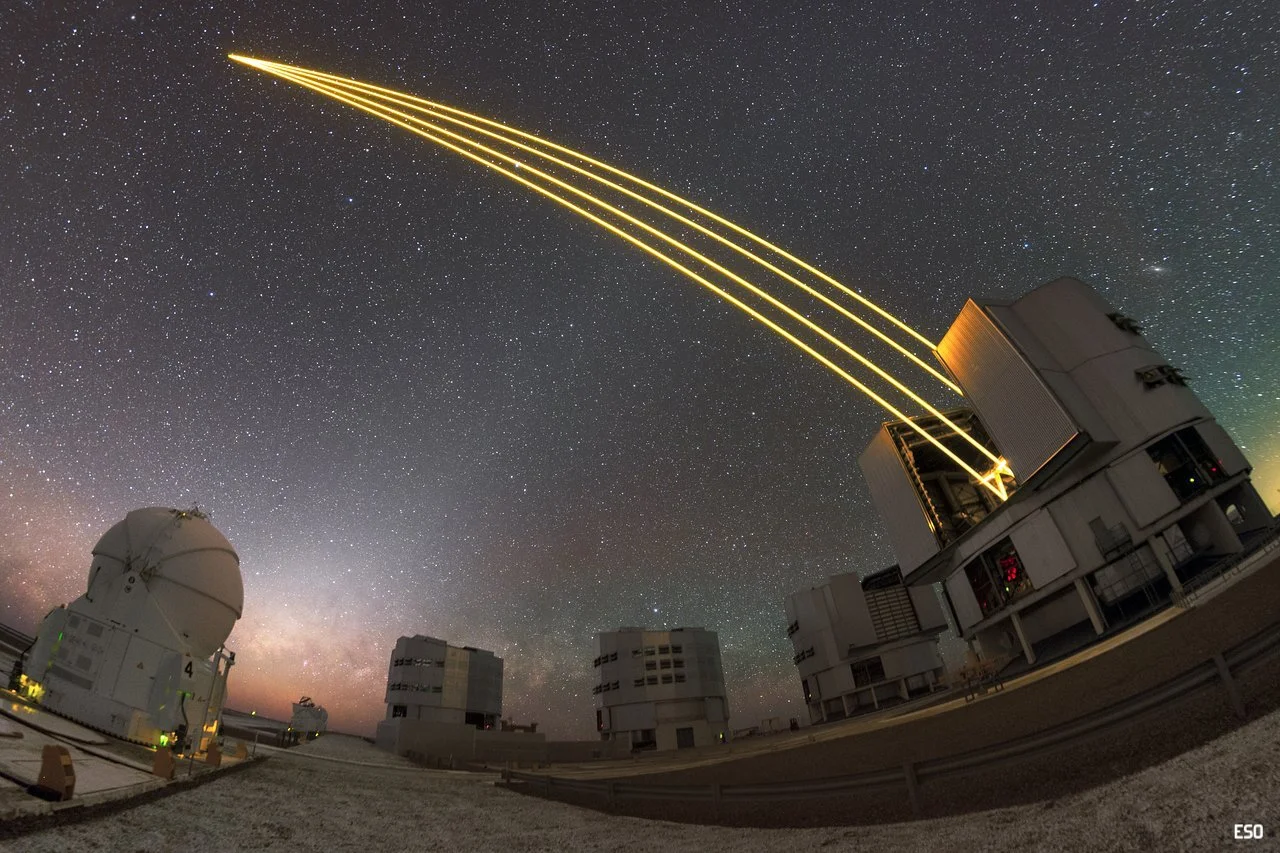
41: Cosmic Microwave Background (Scopes on a Balloon!)
When Chris found out in episode 36 that there was a telescope on an aeroplane, he was joking when he suggested they should try putting one on a balloon. Turns out, that's a real thing — and it leads to a deep-dive into one of the most fascinating discoveries in all of astronomy, the fingerprint of the Big Bang itself: the Cosmic Microwave Background.

40: One Giant Leap
Fifty years ago, a human in a big puffy suit stepped off the bottom rung of a ladder and onto the surface of another world for the first time. Chris and Emily ponder the meaning of that moment for our species, for science, and for the future of space exploration.

39: Ridiculously Large Telescopes
Telescopes — can they every be big enough? With news of serious progress on the Giant Magellan Telescope in Chile, Emily and Chris natter about Astronomy's truly big optical scopes. First there were a slew of Large Telescopes. Then came the VLT, the Very Large Telescope. That wasn't large enough, so we got the Extremely Large Telescope. The Overwhelmingly Large Telescope was planned for a while, but then got cancelled, which sounds like it might have been a good thing. The technology is awesome, the science is astounding — the next decade is going to be a great one for optical astronomy.

38: Blue Twinkly Supergiants
Our Sun is a star, and because it's so close and familiar, we think that's what stars are like. But there are loads of different kinds of stars out there — small ones, cold ones, hot ones, wobbly ones, and really stupidly BIG ones. Emily gets excited in this episode because new research on Blue Supergiant Stars shows they wobble and wiggle, and that can tell us loads about how stars evolve.

37 (supplemental): Syzygy Film Club!
Come to Syzygy LIVE! The Great Syzygy Space Off — 23 May in York! — check the show notes.
While recording ep. 37, Emily and Chris had a vent about a few astro-related (or astro-adjacent) hollywood movies of recent years: Gravity, Interstellar, and — from way back in 2004 — the ludicrous What The BLEEP Do We Know? A few spoilers, but nothing too bad. You have been warned.

37: Crazy Donut Moon Theory
Come to Syzygy LIVE! The Great Syzygy Space Off — 23 May in York! — check the show notes.
Feels like we really should understand where the Moon came from — it's so close, so connected to the Earth, so ... obvious in the sky! Turns out, the Moon's origin story isn't as simple as we thought. Emily dives deep on this one, conjuring wacked-out dynamics involving primal supernovae, colliding planets, greek gods and donuts.

36: Scopes On A Plane!
Not long after the big bang started to fade, and the glowing-hot early universe cooled down a bit, things started to clump together. Not planets, stars and galaxies yet — smaller, much smaller.
First, atomic nuclei: Hydrogen, Helium. They then started to gather electrons to make ions and, eventually, neutral atoms. And finally, the first molecule was formed: HeH+, Helium Hydride — a Helium atom with a Hydrogen ion sticking off one side.
Or at least, that's what astronomers think happened, because no one has ever seen HeH+ anywhere in the universe outside the chemistry lab.
Until now, that is. Astronomers have used an infra-red telescope on an aeroplane (yep, on a PLANE!) to spot the tricksy molecule in a nearby planetary nebula. And turns out, Emily has been on that magic telescope-plane, and has photos to prove it!

35: THAT Black Hole Image
We took an image of a Black Hole!
OK, we know, we know — we're a little late to the party. But we go in deep on this acclaimed image from the Event Horizon Telescope collaboration, to find out what this weird donut thing is all about, why it's NOT an image of the supermassive black hole at the centre of our own galaxy as was widely expected, why the donut seems a bit lopsided, and conclude that this is indeed a first-class addition to the long list of truly iconic astronomical imagery.

34: This System's Got Everything!
We're either just about to add the 4000th exoplanet to our catalogues, or we've already just done it, depending on whether you believe NASA or the Europeans. Either way — exoplanets galore!
So in this episode we celbrate a fascinating story about the Very Large Telescope and its GRAVITY instrument, which has just imaged an exoplanet around a star called HR8799 using optical interferometry for the first time. Even better, something about this story piqued Emily's interest, because there was something strangely familiar about that particular star ...

33: Goldilocks Zones around Binary Stars
We wish York’s Astrocampus a very Happy 5th Birthday, and welcome our very first guest star to the podcast: Bethany Wootton, recent graduate who has published an actual, proper research paper from her Masters degree research — a pretty amazing feat.
Bethany spent a year investigating the habitable zone around binary star systems, where planets are in that Goldilocks position of not-too-hot-but-not-too-cold, where it’s just possible life as we know it could exist. We chat with her about some surprising results from her work, what it’s like doing a project like this during your degree … and how it feels to get published so early in your career!
